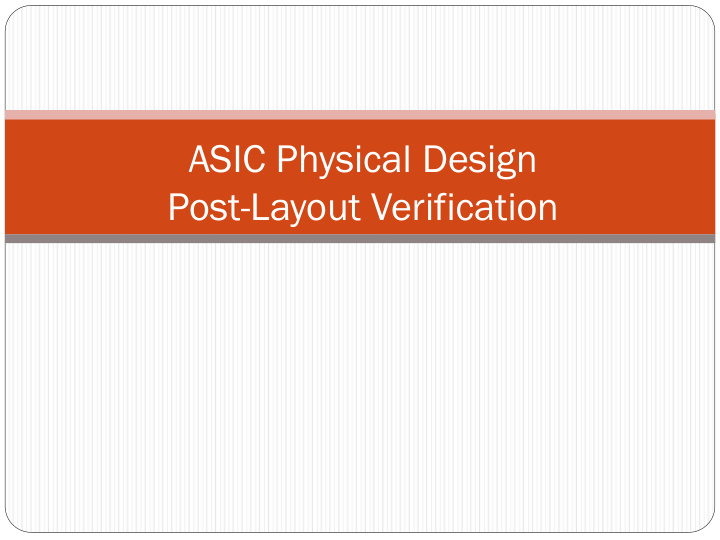



ASIC Physical Design Post-Layout Verification
ASIC Physical Design (Standard Cell) (can also do full custom layout) Component-Level Netlist (Verilog) Std. Cell Cadence: Floorplan Layouts Encounter Chip/Block (std cells) Libraries ICblocks Virtuoso Process Data (chip assembly) Place & Route Design Rules Std. Cells Layout vs. Generate Design Rule Backannotate Schematic Mask Data Check Schematic Check Calibre Calibre Calibre IC Mask Data SPICE/ADiT Simulation Model
Cadence setup Copy files from /class/ELEC6250/CadenceFiles (Replace dot with a period. Example: .cdsenv) dotcdsenv to your home directory dotcdsinit to your project directory cds.lib to your project directory display.drf to your project directory dotsimrc to your project directory addpowerv1.txt to your project directory Edit your .bashrc file with the setup information from /class/ELEC6250/CadenceFiles/dotbasrch
Import digital block into Virtuoso Import GDSII layout information into Virtuoso: Encounter saves: mydesign.gds2 Import into a Cadence library File > Import > Stream Results in cell “layout” view Import circuit netlist into Virtuoso: Gate-level netlist saved by Encounter: mydesign.v Import netlist into a Cadence Library File > Import > Verilog Results in cell “schematic” and “symbol” views Gates replaced by transistors using “cdslib” components (Demonstration)
Virtuoso CIW (Command Interpreter Window) Cadence libraries and tools are accessed from the CIW Import/Export designs Access libraries BICMOS8HP PDK Items
File > Import > Stream GDSII file from Encounter My library for this cell Name of top design cell Technology library Replace Verilog [ ] with < > Click Translate
Importing the Verilog netlist Verilog netlists saved by Synopsys Design Compiler and Cadence Encounter do not contain ports or definitions of power and ground connections. Manually add power/ground connections by executing the following perl script from a linux command line. perl addpowerv1.txt design.v design_vg.v where: addpowerv1.txt is provided with the setup files design.v is the netlist generated by Encounter design_vg.v is the netlist with VDD/GND added
Generated Verilog netlist module modulo6 (VDD, VSS, CLEARbar, L_Cbar, CLK, Power/ground added I, Q); inoutVDD, VSS; input CLEARbar; input L_Cbar; input CLK; input [2:0] I; output [2:0] Q;
File > Import > Verilog My library for this cell Reference tech library* Verilog file(s) * Contains tech file for “311” bicmos8hp Creates schematic and symbol views Replace Verilog [ ] with < >
Library Manager Views created by import New library New cell Double-click on view to open it in the appropriate tool.
Layout view of “modulo6” Calibre LVS/DRC/PEX
Schematic view of “modulo6”
Symbol view of “modulo6”
Verify correctness of layout Open layout in Virtuoso Verify with Calibre or Assura tools LVS (layout vs. schematic) 1. Extract netlist from layout Compare extracted netlist to imported netlist DRC (design rule check) 2. Checks all layout levels Errors should be fixed as appropriate PEX (parameter extraction) 3. Extract netlist from layout, including R/C parameters Simulate netlist to verify functionality and timing
Calibre Layout-vs-Schematic (LVS) Check Layout Schematic
Layout vs schematic check (Calibre Interactive LVS) Compares extracted transistor-level netlist vs. netlist generated from Verilog gate-level netlist From Layout GXL menu: Calibre > Run LVS (Demonstrate ) Mentor Graphics LVS Rules: $ADK/technology/ic/process/tsmc035.calibre.rules Inputs/Layout: will be generated by Calibre Inputs/Netlist: count4.src.net (created in DA-IC) Top-level cell: count4 (schematic name) Inputs/H-cells (hierarchical cells): $ADK/technology/adk.hcell Extracted file: count4.lay.net
Load rules file tsmc035
Calibre inputs Layout to be extracted by Calibre (GDSII format) Layout top cell name Extracted layout netlist Source netlist created in DA-IC Schematic name Hierarchical cells file: $ADK/technology/adk.hcell
Calibre RVE to probe LVS results
Post-layout functional/timing verification (Calibre PEX) Purpose: timing analysis & functional verification of the final design analyze netlist extracted from layout parasitic wire capacitance parasitic wire to wire capacitance net and via resistance perform netlist & parameter extraction with Calibre PEX simulate in ADiT , Eldo, Spectre, PSPICE, HSPICE, etc.
Wire delay estimation T r The distributed RC-line R N-1 R N R 1 R 2 C 1 C 2 C N-1 C N V in 2.5 x= L/10 2 Diffused signal x = L/4 propagation voltage (V) 1.5 x = L/2 1 Delay ~ L 2 x= L 0.5 0 0 0.5 1 1.5 2 2.5 3 3.5 4 4.5 5 time (nsec)
Parameter extraction with Calibre PEX Extract SPICE netlist, including parasitic RC Transistor-level , gate-level, or hierarchical extraction With the layout cell open: In the menu bar: Calibre>Run PEX Input options: similar to Calibre LVS Extraction options (Outputs tab): choose “Transistor level” choose one of: C: lumped C + coupling cap’s RC: distributed RC RCC: distributed RC + coupling cap’s Click “Run PEX” Output files: modulo5.sp - main SPICE model (transistors) modulo5.sp.pex - extracted R/C (lumped) modulo5.sp.MODULO5.pxi - extracted C (coupling)
Extracted file – top level Include extracted R/C N transistor source drain bulk gate
Extracted file – extracted R/C Lumped capacitance Resistance
Calibre PEX inputs Specify rules file: $ADK/technology/ic/process/tsmc035.calibre.rules
Calibre PEX inputs Name of layout file (count4.gds) Specify rule file: GDSII file format Check to generate new layout file Name of top cell (count4) Source(SPICE) netlist created in DA-IC Top-level cell name in SPICE netlist Hierarchical cells file: $ADK/technology/adk.hcell
Calibre PEX netlist output Lumped capacitance Use net names from LAYOUT
Designate GND and VDD nets
Recommend
More recommend